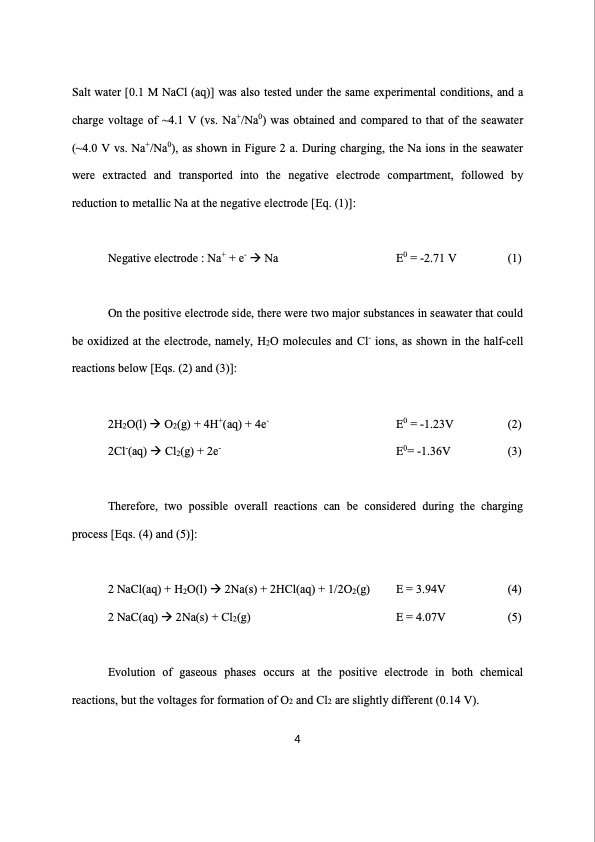
PDF Publication Title:
Text from PDF Page: 004
Salt water [0.1 M NaCl (aq)] was also tested under the same experimental conditions, and a charge voltage of ~4.1 V (vs. Na+/Na0) was obtained and compared to that of the seawater (~4.0 V vs. Na+/Na0), as shown in Figure 2 a. During charging, the Na ions in the seawater were extracted and transported into the negative electrode compartment, followed by reduction to metallic Na at the negative electrode [Eq. (1)]: Negative electrode : Na+ + e- Na E0 = -2.71 V (1) On the positive electrode side, there were two major substances in seawater that could be oxidized at the electrode, namely, H2O molecules and Cl- ions, as shown in the half-cell reactions below [Eqs. (2) and (3)]: 2H2O(l)O2(g) + 4H+(aq) + 4e- E0 = -1.23V (2) 2Cl-(aq)Cl2(g) + 2e- E0= -1.36V (3) Therefore, two possible overall reactions can be considered during the charging process [Eqs. (4) and (5)]: 2 NaCl(aq) + H2O(l)2Na(s) + 2HCl(aq) + 1/2O2(g) E = 3.94V (4) 2 NaC(aq)2Na(s) + Cl2(g) E = 4.07V (5) Evolution of gaseous phases occurs at the positive electrode in both chemical reactions, but the voltages for formation of O2 and Cl2 are slightly different (0.14 V). 4PDF Image | Rechargeable Seawater Battery

PDF Search Title:
Rechargeable Seawater BatteryOriginal File Name Searched:
1337148.pdfDIY PDF Search: Google It | Yahoo | Bing
Product and Development Focus for Salgenx
Redox Flow Battery Technology: With the advent of the new USA tax credits for producing and selling batteries ($35/kW) we are focussing on a simple flow battery using shipping containers as the modular electrolyte storage units with tax credits up to $140,000 per system. Our main focus is on the salt battery. This battery can be used for both thermal and electrical storage applications. We call it the Cogeneration Battery or Cogen Battery. One project is converting salt (brine) based water conditioners to simultaneously produce power. In addition, there are many opportunities to extract Lithium from brine (salt lakes, groundwater, and producer water).Salt water or brine are huge sources for lithium. Most of the worlds lithium is acquired from a brine source. It's even in seawater in a low concentration. Brine is also a byproduct of huge powerplants, which can now use that as an electrolyte and a huge flow battery (which allows storage at the source).We welcome any business and equipment inquiries, as well as licensing our flow battery manufacturing.| CONTACT TEL: 608-238-6001 Email: greg@salgenx.com | RSS | AMP |